Special Report
Oregon Grows More Christmas Trees Than Any Other State
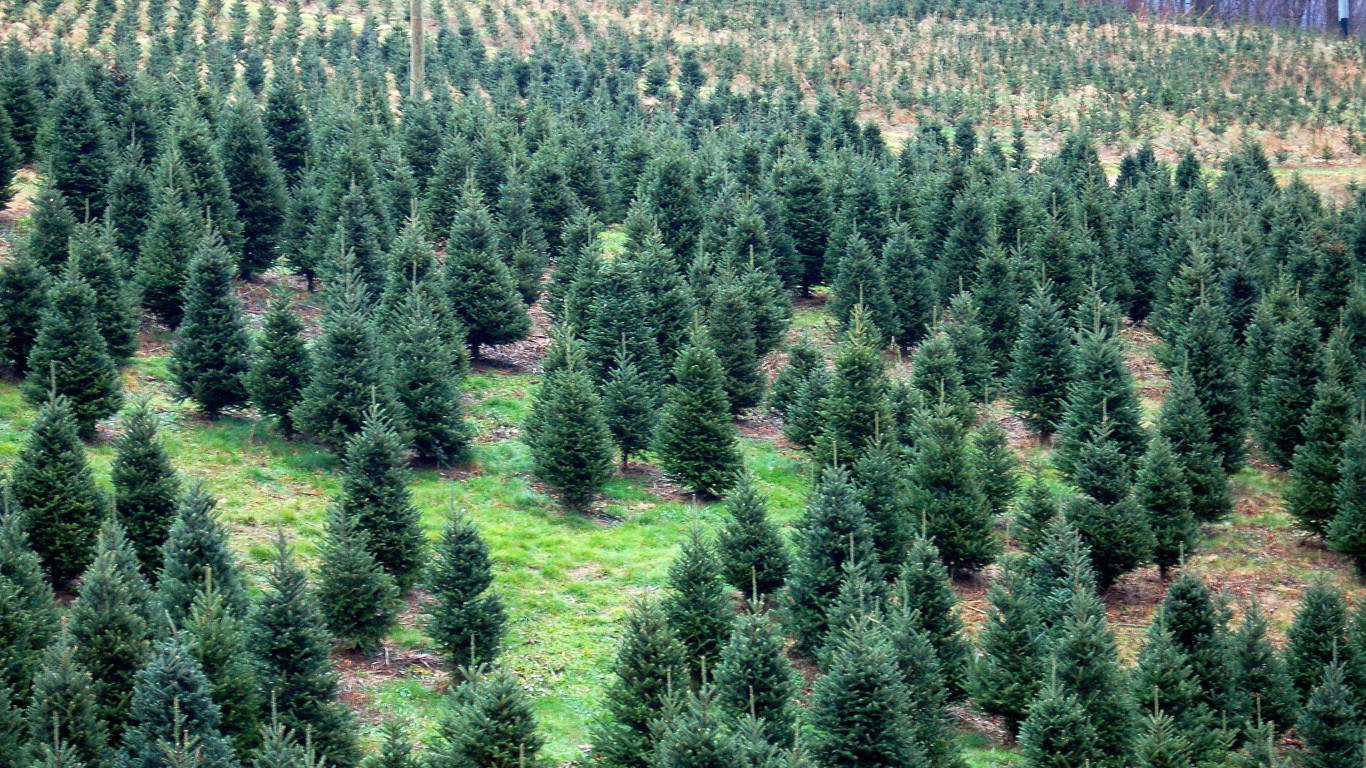
Published:
Last Updated:

Every year, U.S. consumers buy over 25 million real Christmas trees. Tree farms in the United States and Canada provide much of this supply. While every state, including Hawaii, has Christmas tree farms, some states grow far more trees than others. (In addition to agricultural trees, some states also have more forest than others. Here are the states with the most forest.)
According to the USDA, there are over 15,000 Christmas tree farms in the U.S., with the largest 434 farms controlling about 75% of the tree supply. Tree farms utilize nearly 350,000 acres of our nation’s land. Oregon – the state that produces the most Christmas trees – has more than 45,000 acres of tree farms; there are also nearly 39,000 acres in North Carolina and almost 37,000 in Michigan.
To determine the states that produce the most Christmas trees, 24/7 Tempo reviewed the 2017 Census of Agriculture from the United States Department of Agriculture’s National Agricultural Statistics Service. Total acres in production, total trees cut, and number of Christmas tree farms are from 2017 (the latest year for which data is available). Total sales numbers (when available) are from the USDA’s 2019 Census of Horticulture. Populations are from the United States Census Bureau’s 2021 American Communities Survey.
Click here to see the states that produce the most Christmas trees
The East Coast and Midatlantic, the West Coast, the Midwest, and the South are all well-represented among the states that grow the most Christmas trees. States in the Southwest and Great Plains, which tend to be the driest areas of the country, tend to grow fewer Christmas trees – with the notable exceptions of Colorado and Iowa. Several of the top ten Christmas-tree-growing states are also among the most populous states in the nation. (In total area, however, these are the largest states in America.)
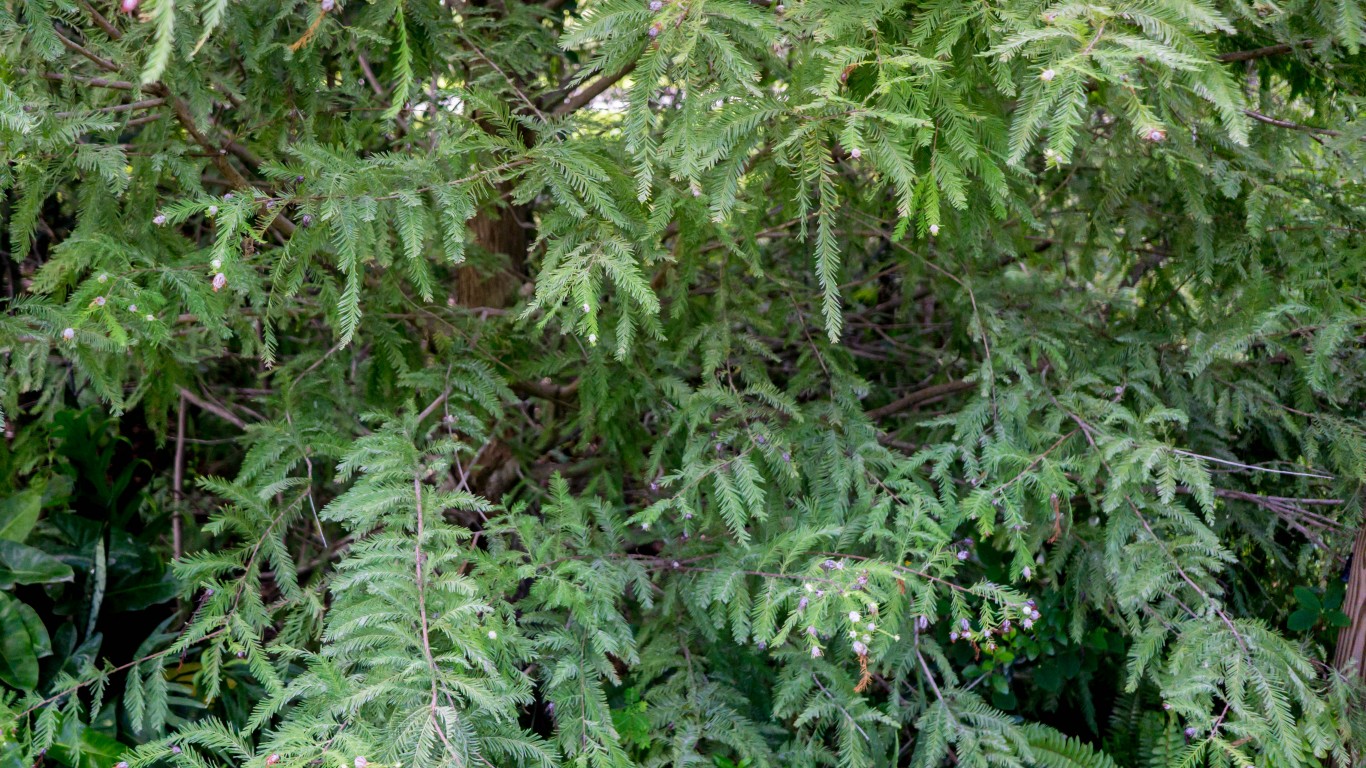
29. Mississippi
> Acres in production (2017): 1,051 (22nd lowest)
> Total trees cut (2017): 12,889 (19th lowest)
> No. of farms (2017): 116 (21st lowest)
> Total sales values (2019): $265,000 (14th lowest)
> Population: 2,949,965 (17th lowest)
[in-text-ad]

28. Iowa
> Acres in production (2017): 1,257 (23rd lowest)
> Total trees cut (2017): 27,387 (24th lowest)
> No. of farms (2017): 139 (24th highest)
> Total sales values (2019): $1 million (23rd highest)
> Population: 3,193,079 (20th lowest)

27. Missouri
> Acres in production (2017): 1,565 (24th lowest)
> Total trees cut (2017): 26,557 (23rd lowest)
> No. of farms (2017): 115 (20th lowest)
> Total sales values (2019): $409,000 (19th lowest)
> Population: 6,168,187 (18th highest)

26. South Carolina
> Acres in production (2017): 1,697 (25th lowest)
> Total trees cut (2017): 27,578 (25th lowest)
> No. of farms (2017): 138 (25th highest)
> Total sales values (2019): $883,000 (25th highest)
> Population: 5,190,705 (23rd highest)
[in-text-ad-2]

25. Florida
> Acres in production (2017): 1,758 (25th highest)
> Total trees cut (2017): 13,968 (20th lowest)
> No. of farms (2017): 158 (23rd highest)
> Total sales values (2019): $363,000 (17th lowest)
> Population: 21,781,128 (3rd highest)
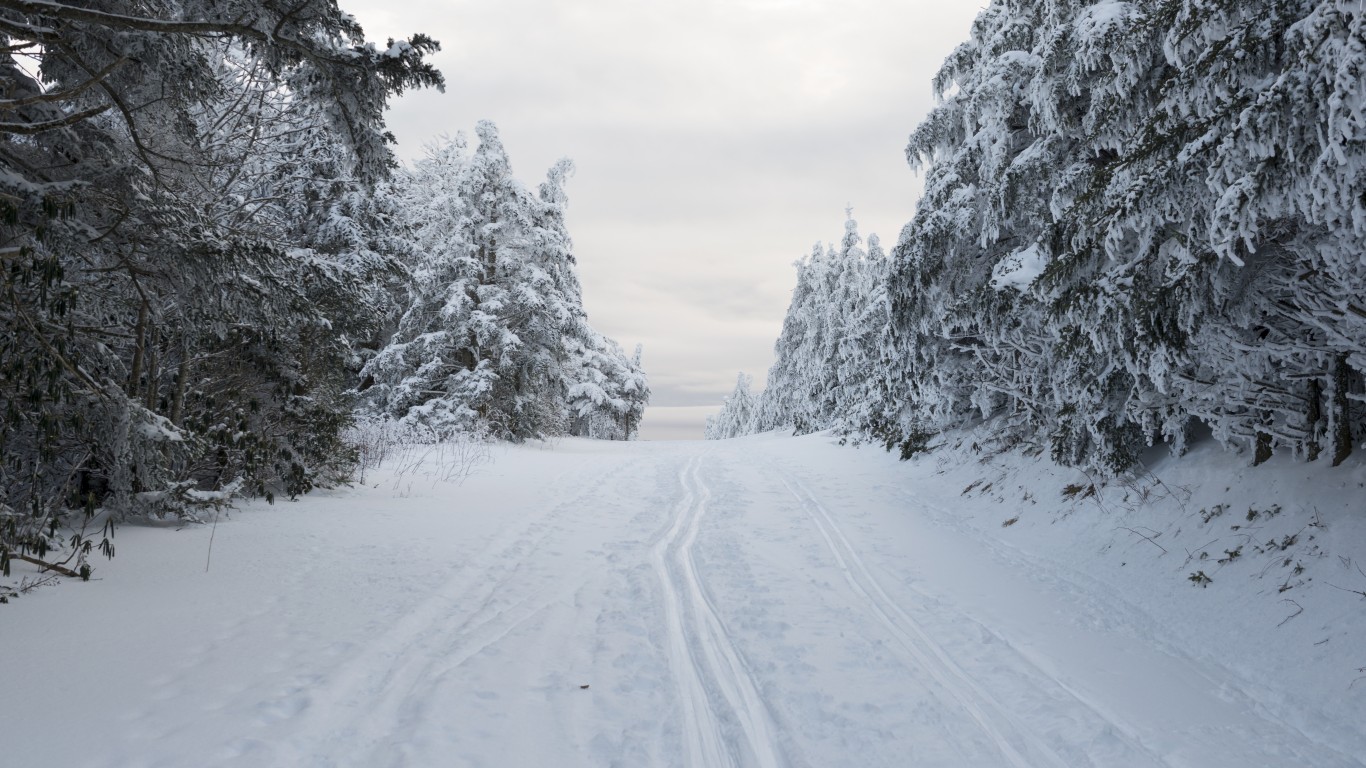
24. Tennessee
> Acres in production (2017): 1,969 (24th highest)
> Total trees cut (2017): 54,005 (20th highest)
> No. of farms (2017): 137 (25th lowest)
> Total sales values (2019): $498,000 (20th lowest)
> Population: 6,975,218 (16th highest)
[in-text-ad]

23. Maryland
> Acres in production (2017): 2,177 (23rd highest)
> Total trees cut (2017): 52,677 (21st highest)
> No. of farms (2017): 187 (22nd highest)
> Total sales values (2019): $2.5 million (19th highest)
> Population: 6,165,129 (19th highest)
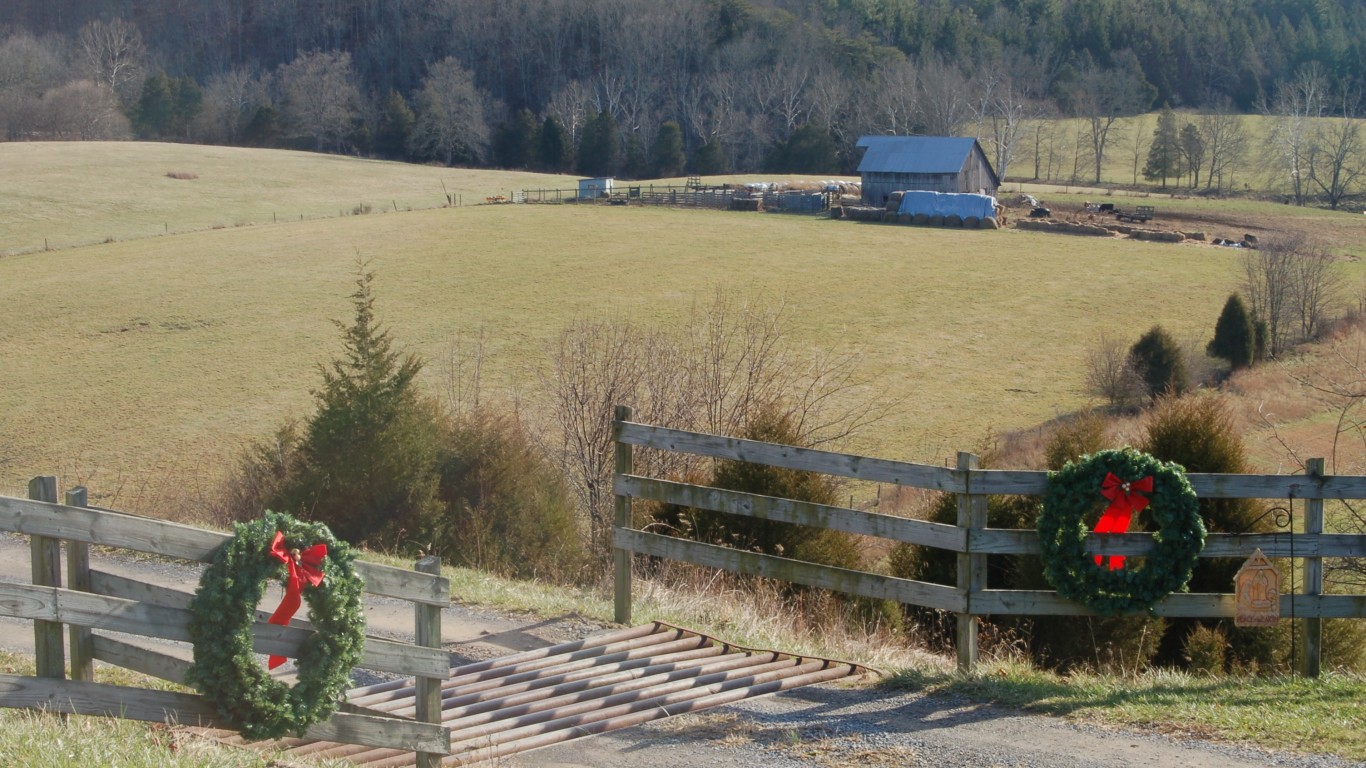
22. West Virginia
> Acres in production (2017): 2,363 (22nd highest)
> Total trees cut (2017): 42,830 (22nd highest)
> No. of farms (2017): 231 (19th highest)
> Total sales values (2019): $741,000 (24th lowest)
> Population: 1,782,959 (12th lowest)

21. Georgia
> Acres in production (2017): 2,412 (21st highest)
> Total trees cut (2017): 32,161 (24th highest)
> No. of farms (2017): 205 (20th highest)
> Total sales values (2019): $2.4 million (20th highest)
> Population: 10,799,566 (8th highest)
[in-text-ad-2]
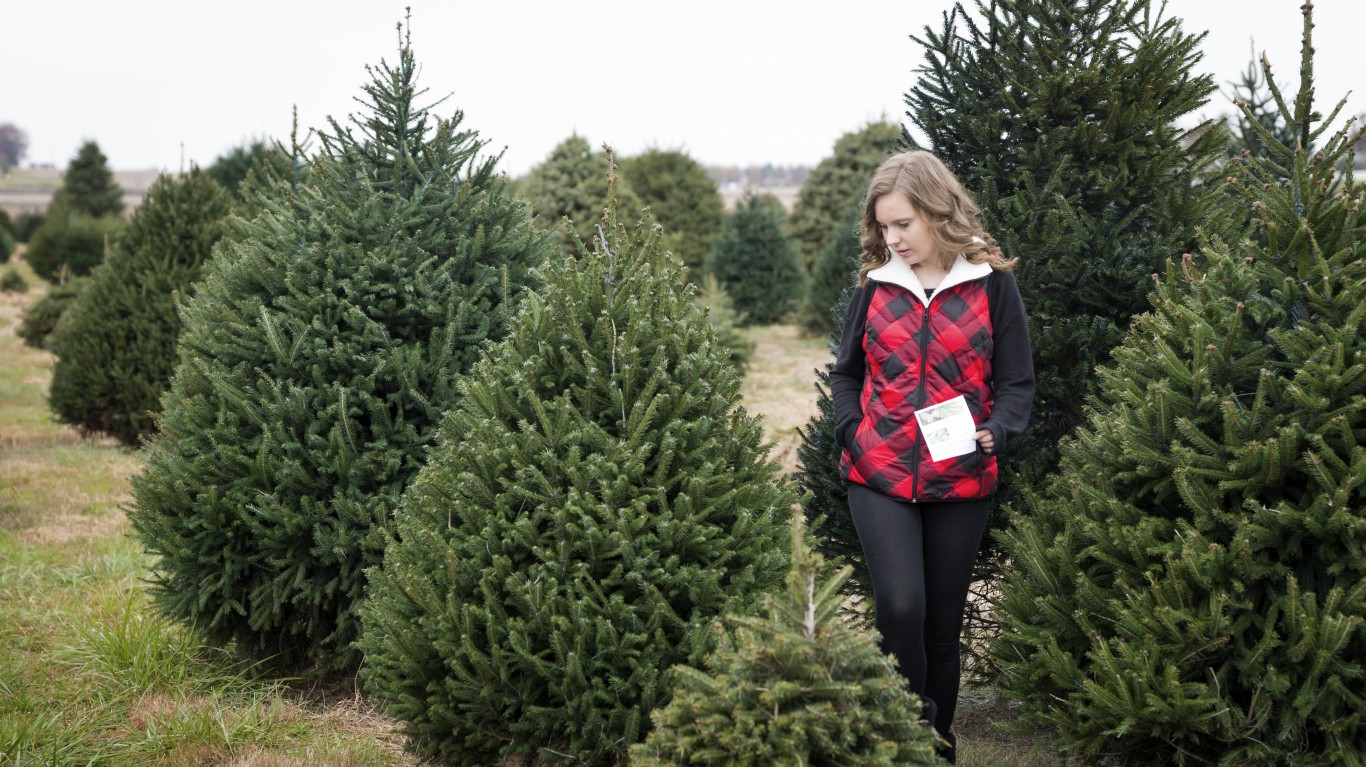
20. Indiana
> Acres in production (2017): 2,663 (20th highest)
> Total trees cut (2017): 90,519 (16th highest)
> No. of farms (2017): 205 (20th highest)
> Total sales values (2019): $2.8 million (17th highest)
> Population: 6,805,985 (17th highest)
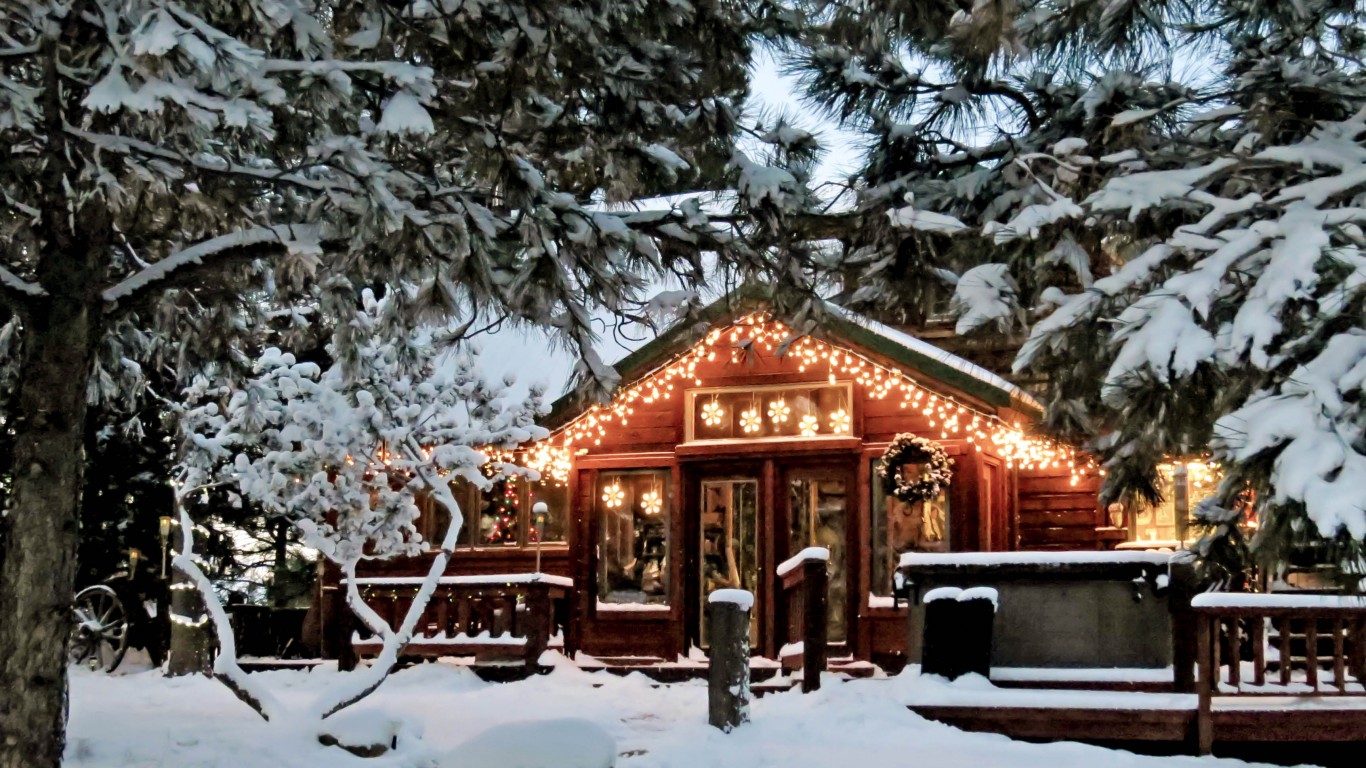
19. Colorado
> Acres in production (2017): 2,681 (19th highest)
> Total trees cut (2017): 10,173 (17th lowest)
> No. of farms (2017): 137 (25th lowest)
> Total sales values (2019): Not available
> Population: 5,812,069 (21st highest)
[in-text-ad]

18. Massachusetts
> Acres in production (2017): 2,801 (18th highest)
> Total trees cut (2017): 82,524 (19th highest)
> No. of farms (2017): 390 (12th highest)
> Total sales values (2019): $3.1 million (13th highest)
> Population: 6,984,723 (15th highest)

17. New Hampshire
> Acres in production (2017): 2,892 (17th highest)
> Total trees cut (2017): 106,703 (14th highest)
> No. of farms (2017): 234 (18th highest)
> Total sales values (2019): $2.9 million (14th highest)
> Population: 1,388,992 (10th lowest)
16. Vermont
> Acres in production (2017): 3,650 (16th highest)
> Total trees cut (2017): 110,459 (13th highest)
> No. of farms (2017): 260 (17th highest)
> Total sales values (2019): $2.8 million (16th highest)
> Population: 645,570 (2nd lowest)
[in-text-ad-2]

15. Illinois
> Acres in production (2017): 3,748 (15th highest)
> Total trees cut (2017): 84,442 (18th highest)
> No. of farms (2017): 272 (16th highest)
> Total sales values (2019): $2.2 million (21st highest)
> Population: 12,671,469 (6th highest)
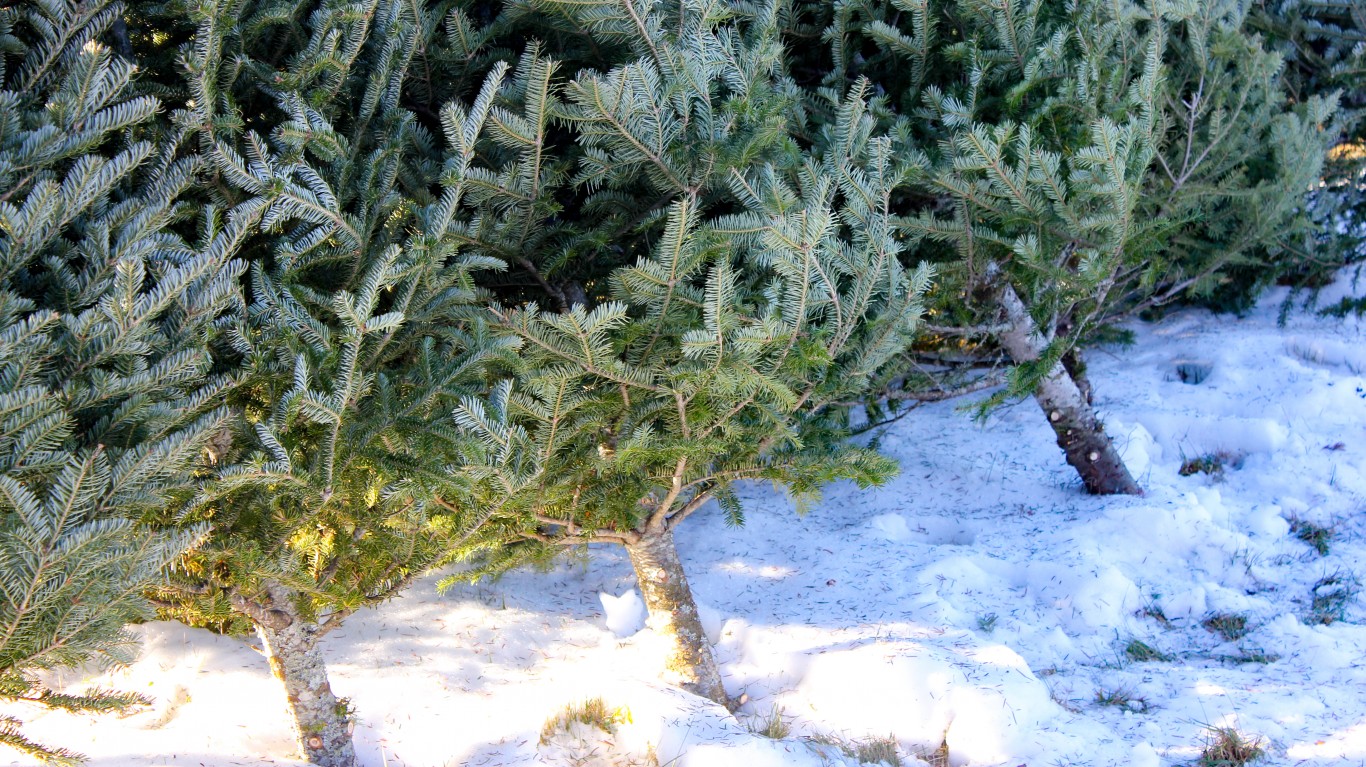
14. Maine
> Acres in production (2017): 4,012 (14th highest)
> Total trees cut (2017): 128,601 (12th highest)
> No. of farms (2017): 332 (13th highest)
> Total sales values (2019): $2.9 million (15th highest)
> Population: 1,372,247 (9th lowest)
[in-text-ad]

13. Connecticut
> Acres in production (2017): 4,149 (13th highest)
> Total trees cut (2017): 98,500 (15th highest)
> No. of farms (2017): 538 (10th highest)
> Total sales values (2019): $4.3 million (12th highest)
> Population: 3,605,597 (22nd lowest)
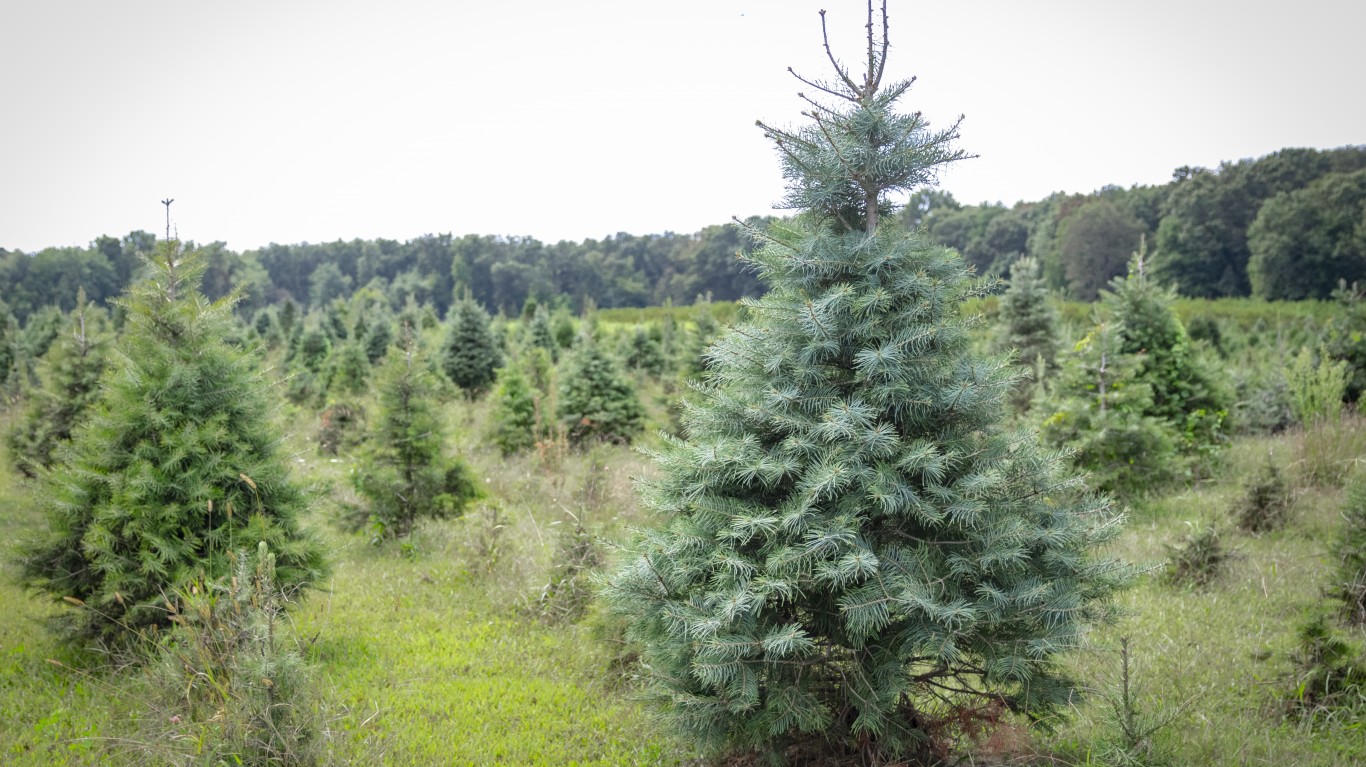
12. New Jersey
> Acres in production (2017): 5,288 (12th highest)
> Total trees cut (2017): 85,781 (17th highest)
> No. of farms (2017): 888 (5th highest)
> Total sales values (2019): $2.8 million (18th highest)
> Population: 9,267,130 (11th highest)
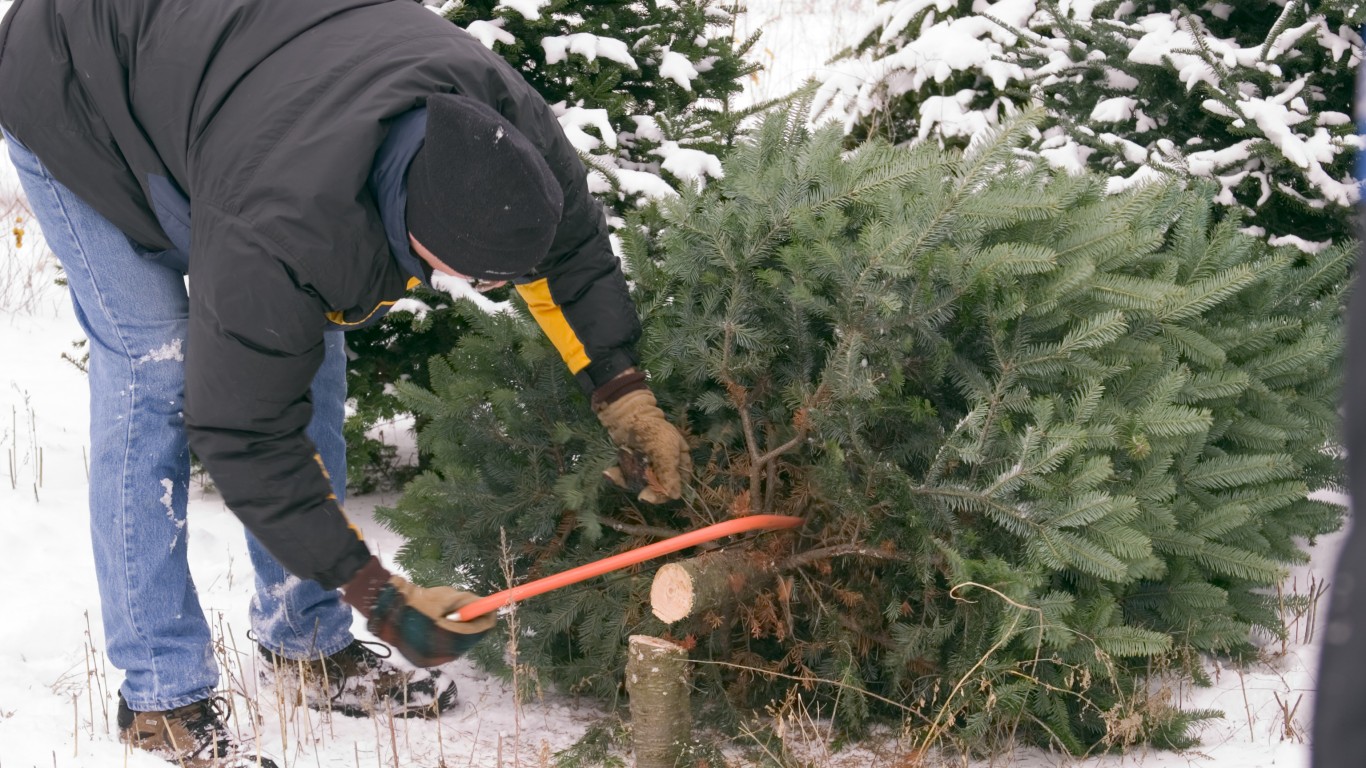
11. Minnesota
> Acres in production (2017): 7,337 (11th highest)
> Total trees cut (2017): 182,532 (9th highest)
> No. of farms (2017): 321 (15th highest)
> Total sales values (2019): $5.7 million (10th highest)
> Population: 5,707,390 (22nd highest)
[in-text-ad-2]

10. Ohio
> Acres in production (2017): 7,714 (10th highest)
> Total trees cut (2017): 155,572 (10th highest)
> No. of farms (2017): 737 (8th highest)
> Total sales values (2019): $8.2 million (9th highest)
> Population: 11,780,017 (7th highest)
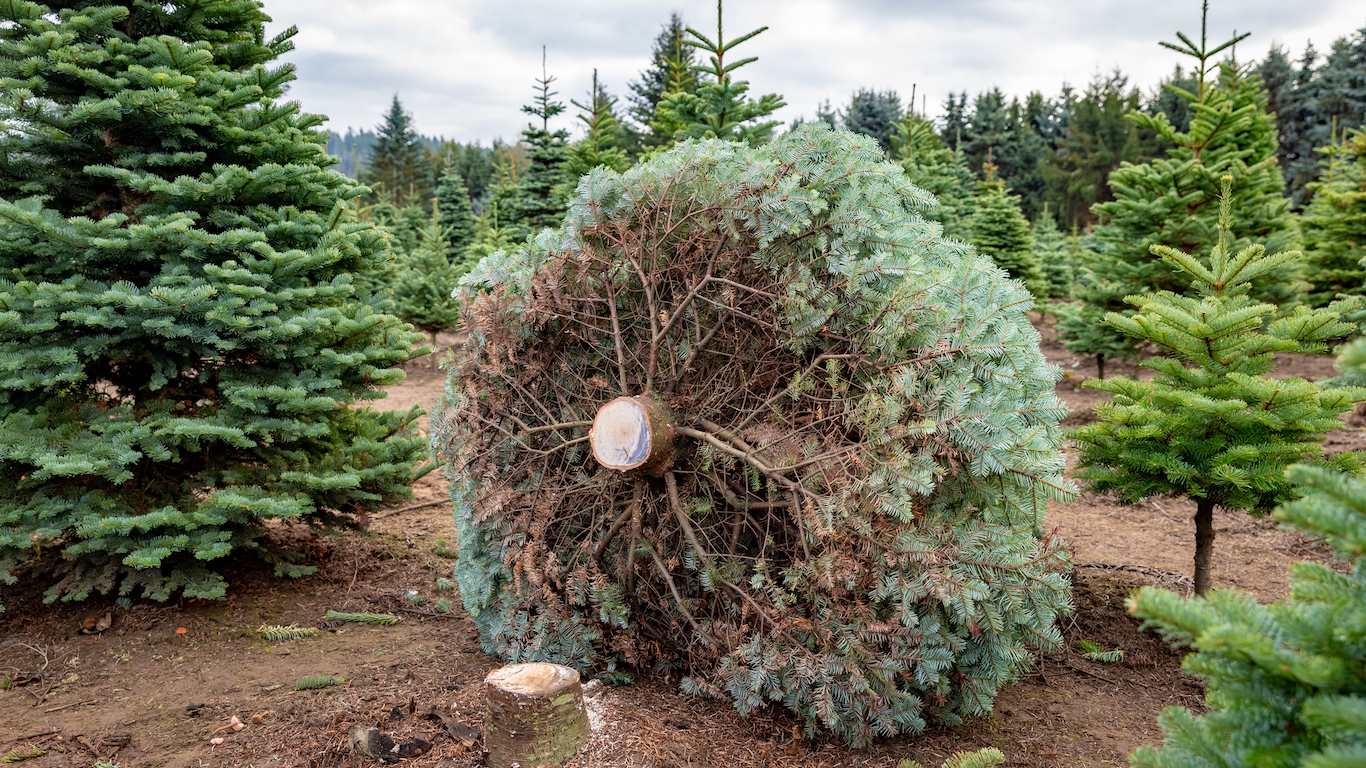
9. Washington
> Acres in production (2017): 7,985 (9th highest)
> Total trees cut (2017): 535,046 (6th highest)
> No. of farms (2017): 670 (9th highest)
> Total sales values (2019): $16.8 million (6th highest)
> Population: 7,738,692 (13th highest)
[in-text-ad]

8. California
> Acres in production (2017): 9,836 (8th highest)
> Total trees cut (2017): 138,803 (11th highest)
> No. of farms (2017): 324 (14th highest)
> Total sales values (2019): $4.6 million (11th highest)
> Population: 39,237,836 (the highest)

7. Virginia
> Acres in production (2017): 11,151 (7th highest)
> Total trees cut (2017): 474,902 (7th highest)
> No. of farms (2017): 464 (11th highest)
> Total sales values (2019): $11.6 million (7th highest)
> Population: 8,642,274 (12th highest)

6. New York
> Acres in production (2017): 19,762 (6th highest)
> Total trees cut (2017): 295,260 (8th highest)
> No. of farms (2017): 1,187 (4th highest)
> Total sales values (2019): $8.7 million (8th highest)
> Population: 19,835,913 (4th highest)
[in-text-ad-2]
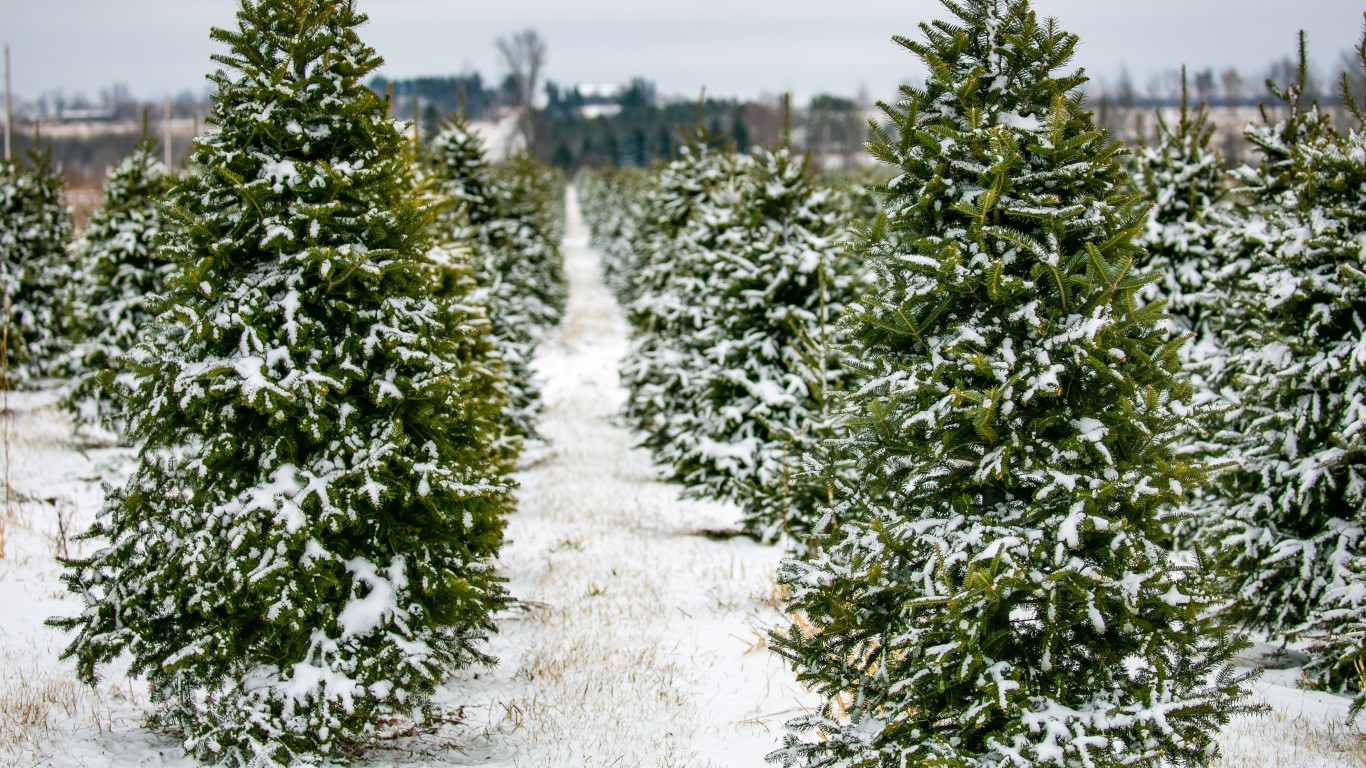
5. Wisconsin
> Acres in production (2017): 23,373 (5th highest)
> Total trees cut (2017): 700,341 (5th highest)
> No. of farms (2017): 859 (6th highest)
> Total sales values (2019): $23.3 million (4th highest)
> Population: 5,895,908 (20th highest)
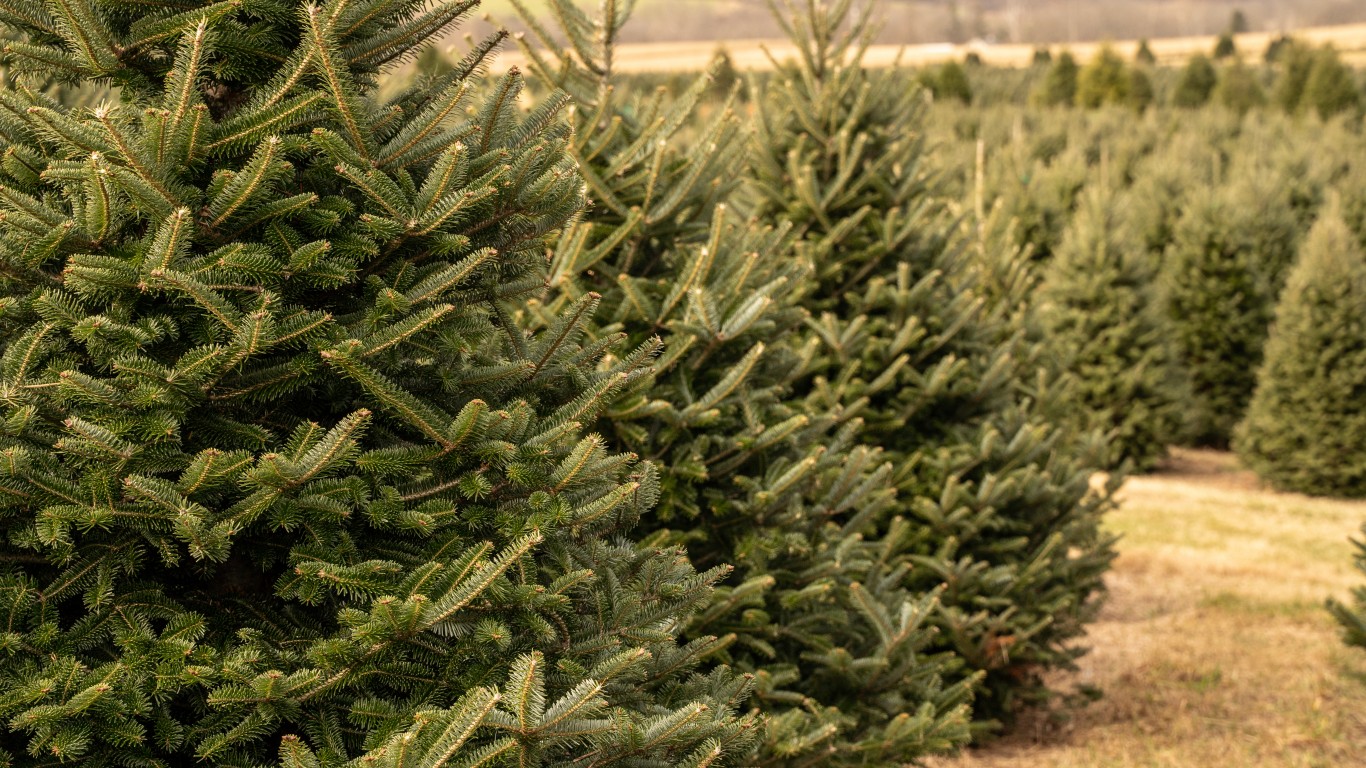
4. Pennsylvania
> Acres in production (2017): 30,793 (4th highest)
> Total trees cut (2017): 1,050,159 (4th highest)
> No. of farms (2017): 1,281 (2nd highest)
> Total sales values (2019): $19.2 million (5th highest)
> Population: 12,964,056 (5th highest)
[in-text-ad]

3. Michigan
> Acres in production (2017): 36,986 (3rd highest)
> Total trees cut (2017): 1,551,185 (3rd highest)
> No. of farms (2017): 1,233 (3rd highest)
> Total sales values (2019): $41.4 million (3rd highest)
> Population: 10,050,811 (10th highest)
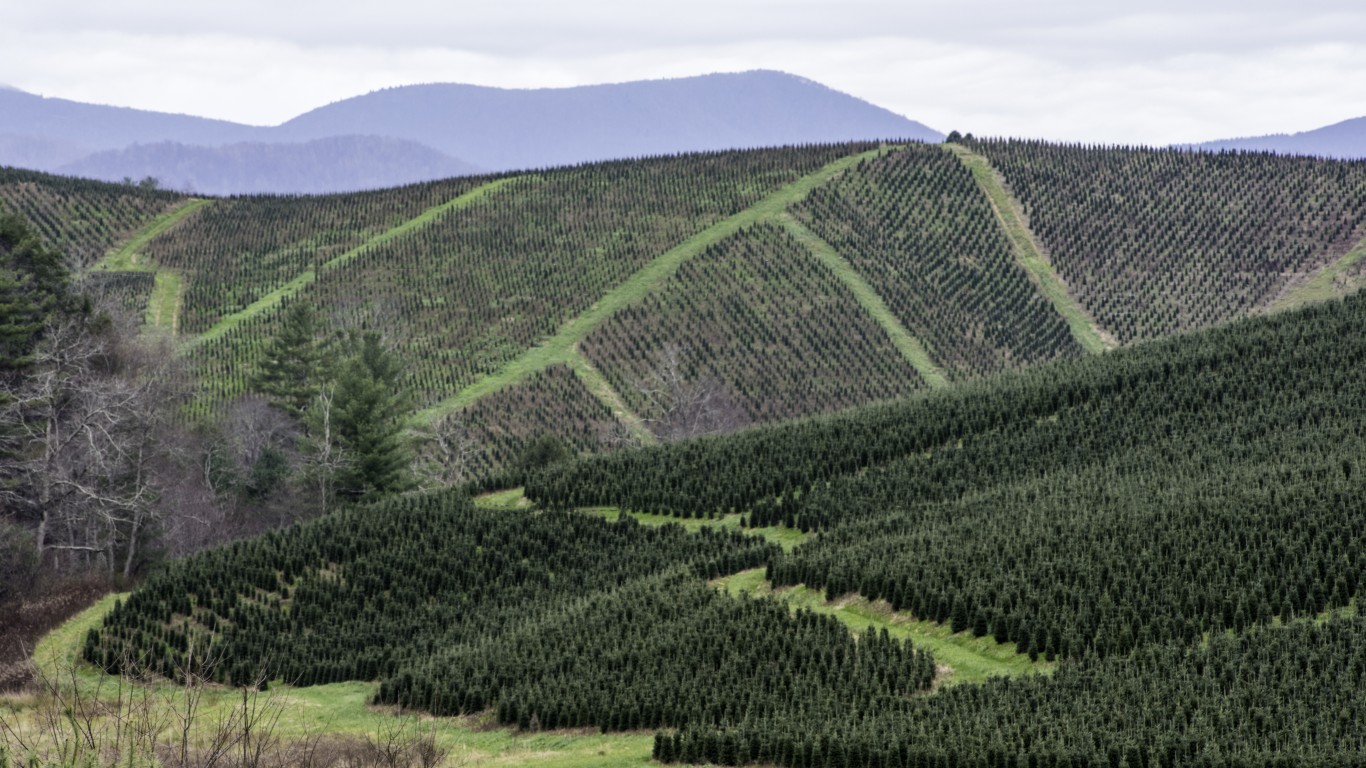
2. North Carolina
> Acres in production (2017): 38,893 (2nd highest)
> Total trees cut (2017): 4,031,864 (2nd highest)
> No. of farms (2017): 854 (7th highest)
> Total sales values (2019): $67.2 million (2nd highest)
> Population: 10,551,162 (9th highest)
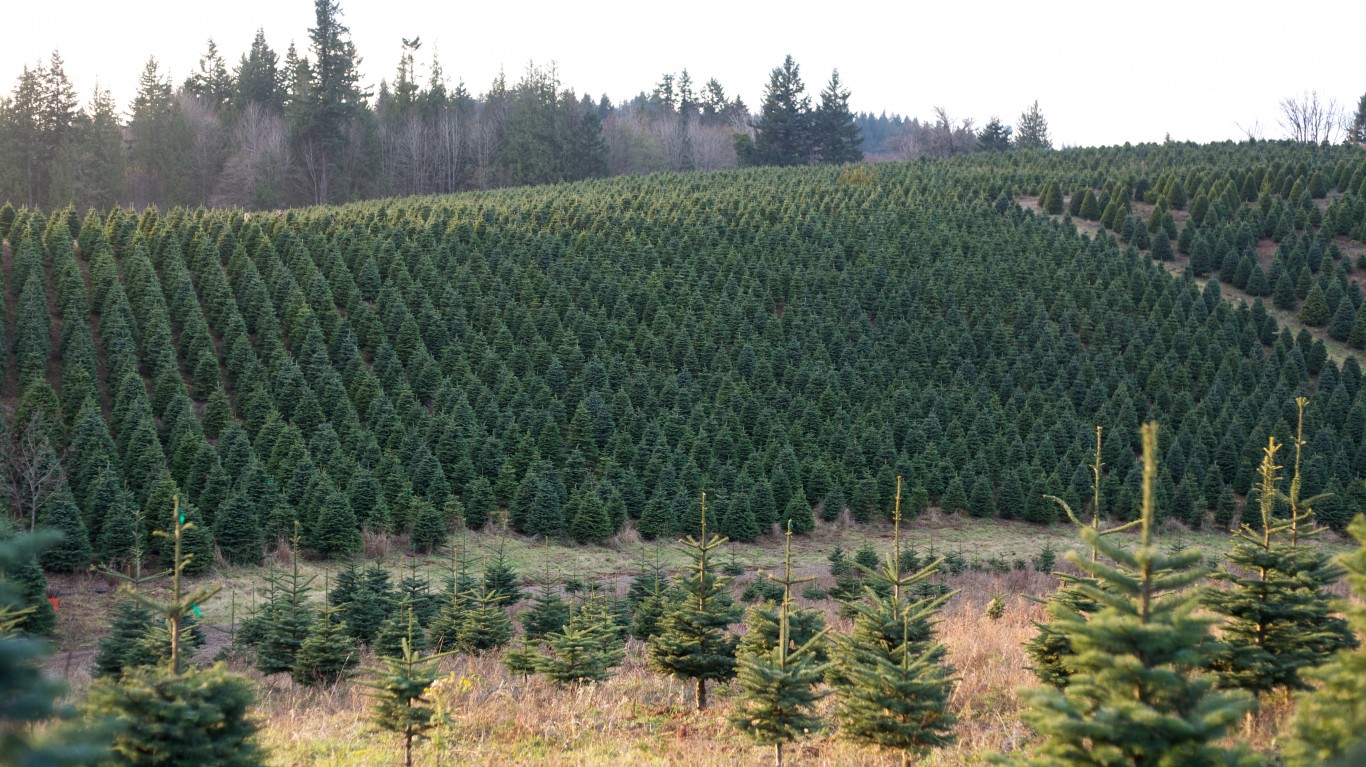
1. Oregon
> Acres in production (2017): 45,283 (the highest)
> Total trees cut (2017): 4,714,298 (the highest)
> No. of farms (2017): 1,431 (the highest)
> Total sales values (2019): $110.3 million (the highest)
> Population: 4,246,155 (24th lowest)
Are you ahead, or behind on retirement? For families with more than $500,000 saved for retirement, finding a financial advisor who puts your interest first can be the difference, and today it’s easier than ever. SmartAsset’s free tool matches you with up to three fiduciary financial advisors who serve your area in minutes. Each advisor has been carefully vetted and must act in your best interests. Start your search now.
If you’ve saved and built a substantial nest egg for you and your family, don’t delay; get started right here and help your retirement dreams become a retirement reality.
Thank you for reading! Have some feedback for us?
Contact the 24/7 Wall St. editorial team.